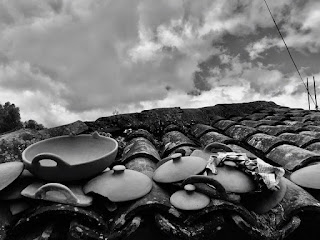The Pottery of Barrio Cera in Loja Ecuador
North of the City of Loja in Southern Ecuador is the Parish of Taquil with an internationally renowned pottery making center known simply as "Barrio Cera." You will be alerted that you have reached this craft mecca when you spot the giant ceramic cooking pot and lid at the entrance to the neighborhood. Getting to Barrio Cera is a rugged ride, but it offers spectacular views along the way.
Cera’s potters have been passing down their craft from generation to generation as a means of earning income in addition to the local agriculture and livestock raising that takes up most of the day.
Upwards of 80 percent of the barrio’s residents engage in the production of ceramic table and cooking utensils and decor pieces. Cera’s artisans are mostly adult women with men and children lending a hand when large orders come in. Not at all a parochial undertaking, resellers come to gather goods to retail in Quito and other northern Sierra craft markets. Cera’s masters have also studied advanced techniques as the guests of Peru, and have exhibited as far away as Switzerland. A main market for the pots and decorative items are at craft exhibitions in Loja, the most economically important events being Loja’s annual Provincial Feria and the tourism generated by the pilgrimage accompanying the procession of Loja’s Virgin del Cisne.
The style of pottery cultivated in Cera is among the oldest on earth. Local clay available near the workshops about two meters under the soil provides no-cost raw materials that produce an especially desirable lustrous finish because of the natural mica inclusions. The potters hand-build the pots rather than throwing them on a potter's wheel or putting liquid clay slurry into molds, which are the more common practices in other parts of the world. Cera’s crafters flatten the local clay into workable disks by hand (or even by foot to take advantage of body weight) or "pinch form" the clay into the rough shape of the finished vessel. The item is then pounded into shape with special tools, also hand-made, and then burnished with the same special tools or with bare hands.
Nearly completed ceramics might then be decorated by embossing them with "found" objects such as metal fragments to create representations of locally seen natural forms like flowers, leaves, and animals. Pots and objects are finally dried, glazed, and then fired in locally built kilns. The resulting cookware is strong enough to take direct heat on cooktop burners, but is really prized for the excellent long- simmering dishes they produce.
If you would like more information about visiting Cera’s potters and the many other attractions of Taquil Canton, contact Life In Loja by email or phone/WhatsApp at 593-098-674-5994 to begin a conversation.
Photos:
Barrio Cera was photographed by young Lojano painter, 'Kahlo' Depiedra (Jairo Geovanny Piedra Tenecela), a graduate of UTPL, Loja technical university’s art program. Depiedra says he looks for the inner beauty of his subject, which comes through very clearly in the images he captured of Barrio Cera.






Comments
Post a Comment